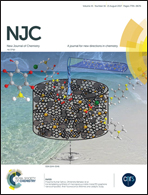Porphyrin stacks as an efficient molecular glue to induce chirality in hetero-component calixarene–porphyrin assemblies†‡
Abstract
Tritopic tris-calix[4]arene TC4 – possessing three divergent cavities linked to a tris-aminophenylamine core – forms, in the presence of tetra-anionic Cu(II) porphyrins CuTPPS or a combination of different metallo-porphyrins (CuTPPS, NiTPPS and MnTPPS), discrete 3 : 1 porphyrin/tris-calixarene complexes. The 3 : 1-(CuTPPS/TC4) complex in particular is shown to be a key building block for the assembly of supramolecular architectures of increasing complexity. Directional (radial vs. stacked) self-assembly of these nanostructures was achieved by alternate addition of selected hetero-components in a programmed fashion. Addition of TC4 and CuTPPS, in turn, leads to a radial growth of the assembly, whereas, addition of single-cavity calix[4]arene C4 stoppers followed by a CuTPPS topping, promotes a stacked growth. In the latter case, the use of chiral (R)- or (S)-C4 stoppers is seen to induce chirality in the whole assembly. Circular dichroism data ultimately suggest that porphyrin molecules located above/below the 3 : 1 core complex act as a “molecular glue”, by making the interaction between chiral calix[4]arenes (R)- or (S)-C4 and the achiral 3 : 1-(CuTPPS/TC4) complex stronger.



 Please wait while we load your content...
Please wait while we load your content...